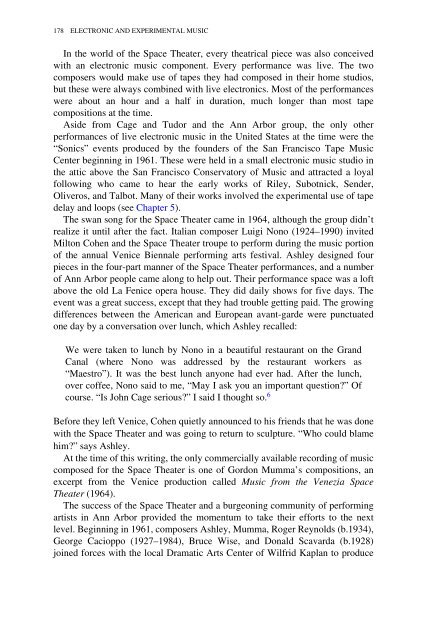Electronic and Experimental Music: Pioneers in ... - Aaaaarg
Electronic and Experimental Music: Pioneers in ... - Aaaaarg
Electronic and Experimental Music: Pioneers in ... - Aaaaarg
Create successful ePaper yourself
Turn your PDF publications into a flip-book with our unique Google optimized e-Paper software.
178 ELECTRONIC AND EXPERIMENTAL MUSIC<br />
In the world of the Space Theater, every theatrical piece was also conceived<br />
with an electronic music component. Every performance was live. The two<br />
composers would make use of tapes they had composed <strong>in</strong> their home studios,<br />
but these were always comb<strong>in</strong>ed with live electronics. Most of the performances<br />
were about an hour <strong>and</strong> a half <strong>in</strong> duration, much longer than most tape<br />
compositions at the time.<br />
Aside from Cage <strong>and</strong> Tudor <strong>and</strong> the Ann Arbor group, the only other<br />
performances of live electronic music <strong>in</strong> the United States at the time were the<br />
“Sonics” events produced by the founders of the San Francisco Tape <strong>Music</strong><br />
Center beg<strong>in</strong>n<strong>in</strong>g <strong>in</strong> 1961. These were held <strong>in</strong> a small electronic music studio <strong>in</strong><br />
the attic above the San Francisco Conservatory of <strong>Music</strong> <strong>and</strong> attracted a loyal<br />
follow<strong>in</strong>g who came to hear the early works of Riley, Subotnick, Sender,<br />
Oliveros, <strong>and</strong> Talbot. Many of their works <strong>in</strong>volved the experimental use of tape<br />
delay <strong>and</strong> loops (see Chapter 5).<br />
The swan song for the Space Theater came <strong>in</strong> 1964, although the group didn’t<br />
realize it until after the fact. Italian composer Luigi Nono (1924–1990) <strong>in</strong>vited<br />
Milton Cohen <strong>and</strong> the Space Theater troupe to perform dur<strong>in</strong>g the music portion<br />
of the annual Venice Biennale perform<strong>in</strong>g arts festival. Ashley designed four<br />
pieces <strong>in</strong> the four-part manner of the Space Theater performances, <strong>and</strong> a number<br />
of Ann Arbor people came along to help out. Their performance space was a loft<br />
above the old La Fenice opera house. They did daily shows for five days. The<br />
event was a great success, except that they had trouble gett<strong>in</strong>g paid. The grow<strong>in</strong>g<br />
differences between the American <strong>and</strong> European avant-garde were punctuated<br />
one day by a conversation over lunch, which Ashley recalled:<br />
We were taken to lunch by Nono <strong>in</strong> a beautiful restaurant on the Gr<strong>and</strong><br />
Canal (where Nono was addressed by the restaurant workers as<br />
“Maestro”). It was the best lunch anyone had ever had. After the lunch,<br />
over coffee, Nono said to me, “May I ask you an important question?” Of<br />
course. “Is John Cage serious?” I said I thought so. 6<br />
Before they left Venice, Cohen quietly announced to his friends that he was done<br />
with the Space Theater <strong>and</strong> was go<strong>in</strong>g to return to sculpture. “Who could blame<br />
him?” says Ashley.<br />
At the time of this writ<strong>in</strong>g, the only commercially available record<strong>in</strong>g of music<br />
composed for the Space Theater is one of Gordon Mumma’s compositions, an<br />
excerpt from the Venice production called <strong>Music</strong> from the Venezia Space<br />
Theater (1964).<br />
The success of the Space Theater <strong>and</strong> a burgeon<strong>in</strong>g community of perform<strong>in</strong>g<br />
artists <strong>in</strong> Ann Arbor provided the momentum to take their efforts to the next<br />
level. Beg<strong>in</strong>n<strong>in</strong>g <strong>in</strong> 1961, composers Ashley, Mumma, Roger Reynolds (b.1934),<br />
George Cacioppo (1927–1984), Bruce Wise, <strong>and</strong> Donald Scavarda (b.1928)<br />
jo<strong>in</strong>ed forces with the local Dramatic Arts Center of Wilfrid Kaplan to produce












